The End of the War in Asia
Atomic Bombs dropped on Japan
During the final stages of World War II in 1945, the United States conducted two atomic bombings against the cities of Hiroshima and Nagasaki in Japan, the first on August the 6th., 1945 and the second on August the 9th., 1945.
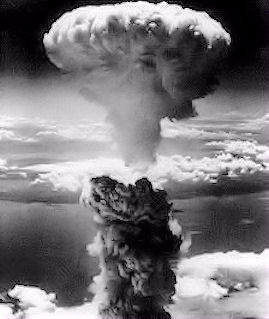 For six months before the atomic bombings, the United States intensely bombed 67 Japanese cities. Together with the United Kingdom and the Republic of China, the United States called for a surrender of Japan in the "Potsdam Declaration" on July the 26th., 1945. The Japanese government ignored this ultimatum. By executive order of President Harry S. Truman, the U.S. dropped the nuclear weapon called "Little Boy" on the city of Hiroshima on Monday, August the 6th.
For six months before the atomic bombings, the United States intensely bombed 67 Japanese cities. Together with the United Kingdom and the Republic of China, the United States called for a surrender of Japan in the "Potsdam Declaration" on July the 26th., 1945. The Japanese government ignored this ultimatum. By executive order of President Harry S. Truman, the U.S. dropped the nuclear weapon called "Little Boy" on the city of Hiroshima on Monday, August the 6th.
In the early morning of August the 9th., the Soviet Union entered the war against Japan's western front with a massive offensive in Manchuria. A few hours later this was followed by the detonation of the nuclear weapon called "Fat Man" over Nagasaki on August the 9th., which inflicted tremendous damage on the west coast city (photo). The immediate and lingering effects of the two revolutionary weapons killed between 100,000 and 200,000 Japanese. Ironically, far more Japanese died in the intervening 6 days as a result of the Russian invasion of Manchuria before the surrender. America had estimated that a conventional counter attack to take back Japanese won territory in Asia and the Pacific, and to capture Japan would have cost the lives of up to one million Allied soldiers.
On August the 14th., the Suzuki government notified the Allies that it had accepted the Potsdam Declaration. On August the 15th., a recording of Emperor Hirohito's surrender speech was broadcast over the radio signifying the unconditional surrender of Japan's military forces.
Disbelief in Changi
The rumour that America had dropped an atomic bomb on Japan was at first treated as "preposterous" by the POWs, however soon the end of the war was announced by the British High Command and Singapore was liberated by the Indian 8th. Division. Bob was awoken by an excited group gathered round the door of Hut E1 when the news came through that the war was over. To save some face the Japs wanted to improve the health of the prisoners before the arrival of Allied Occupational Forces so they released food supplies and the men began to put on weight.
Lord Mountbatten, Supreme Allied Commander, South East Asia Command, was present at the reception of the Japanese surrender in Singapore when British troops returned to the island to receive the formal surrender of Japanese forces in the region led by General Itagaki Seishiro on the 12th. September 1945, almost a month after the Japanese Emperor's announcement of the surrender. The second in command to General Douglas MacArthur, General Robert L Eichelberger was also present and an early visitor to Changi prisons, where he asked to see the broom radio which was demonstrated by Bob and Russel Wright - a succession of official photos were taken.
 |
 |
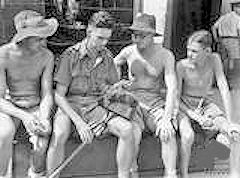 |
 |
Occuping Forces and the Red Cross in Changi
Occupying Forces saw with disbelief the condition of the POWs after 3 years of forced labour prison life, working around Singapore, on the Siam - Burma Railway and then the Changi Aerodrome, under fed, diseased and in skeletal conditions. Seriously ill prisoners were flown out almost immediately - those to Australia were flown in a wonderful effort by Catalina flying boats in an almost non stop operation.
"After 6 weeks we boarded the Largs Bay for the voyage home"...
 |
 |
 |
 |
 |
 |
The Red Cross moved in with the occupying forces and took over providing food for the prisoners who remained in Singapore, however they were more interested in their own well-being more so than the prisoners, which resulted in Mountbatten removing them from Changi.
The Japanese now became prisoners
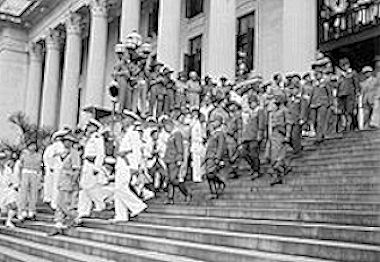 On the 6th. and 9th. of August 1945, U.S. B 29 bombers dropped two atomic bombs on the Japanese cities of Hiroshima and Nagasaki. On the 8th. of August 1945, the Soviet Union declared war on Japan and invaded Manchuria. The bombing of Hiroshima and Nagasaki along with the entry of the Soviet Union into the war ended the Japanese occupation of Southeast Asia. On the 15th. August, Japan announced its surrender. In Singapore, the formal signing of the surrender instrument was held at City Hall, then known as "Municipal Hall", on the 12th. September 1945.
On the 6th. and 9th. of August 1945, U.S. B 29 bombers dropped two atomic bombs on the Japanese cities of Hiroshima and Nagasaki. On the 8th. of August 1945, the Soviet Union declared war on Japan and invaded Manchuria. The bombing of Hiroshima and Nagasaki along with the entry of the Soviet Union into the war ended the Japanese occupation of Southeast Asia. On the 15th. August, Japan announced its surrender. In Singapore, the formal signing of the surrender instrument was held at City Hall, then known as "Municipal Hall", on the 12th. September 1945.
This was followed by a celebration at the Padang, which included a victory parade. Lord Louis Mountbatten, Supreme Allied Commander of Southeast Asia Command, came to Singapore to receive the formal surrender of the Japanese forces in the region from General Itagaki Seishiro on behalf of General Hisaichi Terauchi. By then, the Japanese allowed the Allies to send in forces and food supplies. Prisoners of war were checked by medical officers and arrangements were made to send them home.
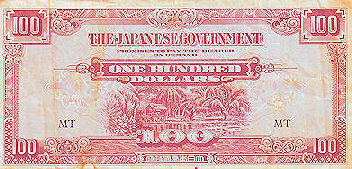 After the Japanese surrender, there was a state of anomy in Singapore, as the British had not yet arrived to take control. The Japanese occupiers had a considerably weakened hold over the populace. There were widespread incidents of looting and revenge killing. Much of the infrastructure had been wrecked, including the harbour facilities and electricity, water supply, and telephone services. When British troops finally arrived they were met with cheering and fanfare. Japanese occupation money (Banana money) became worthless after the occupation ended. Many individuals who had acquired their wealth through banana currency were rendered penniless overnight.
After the Japanese surrender, there was a state of anomy in Singapore, as the British had not yet arrived to take control. The Japanese occupiers had a considerably weakened hold over the populace. There were widespread incidents of looting and revenge killing. Much of the infrastructure had been wrecked, including the harbour facilities and electricity, water supply, and telephone services. When British troops finally arrived they were met with cheering and fanfare. Japanese occupation money (Banana money) became worthless after the occupation ended. Many individuals who had acquired their wealth through banana currency were rendered penniless overnight.
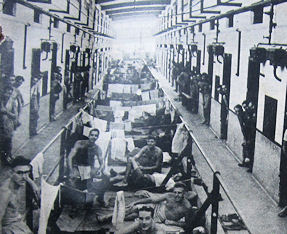 |
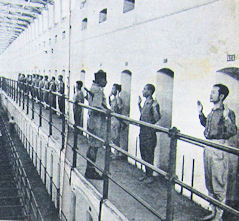 |
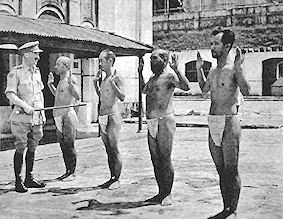 |
| Allied POWs in Changi Goal - 3 men to a cell - others sleeping on the grating | Jap Officers in Changi Goal - 1 man to a cell | Senior Jap Officers - Major-General Mastochi Saito (Malay), Mikizawa (Outram Road), Tominago (Changi) and Ogata - Australian War Trials tried and hanged 18 Japanese at Singapore. |
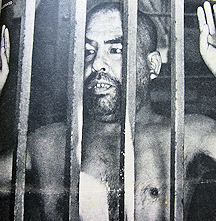 |
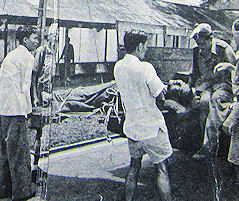 |
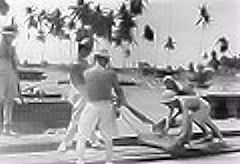 |
| Capt. Tominago - the freed Allies affectionally called him "Might Have Been", "No More", "Too Late", "Farwell" or "Maybe" | Recovering a Jap Officer's body after "Hari Kari" | Japanese POWs working on the Changi aerodrome - now British |
The Japanese, now prisoners themselves, were used to help clear up the detritus of war at Changi, and to work on improving the airfield. Their conditions of work were humane, unlike the treatment they meted out to their prisoners. Imprisoned Japanese troops were then made to improve the runways, reinforcing the north south runway for military aircraft and adding perforated steel plates to the east-west runway. The British military administration utilized surrendered Japanese troops as security forces to help to govern the island until March 1946.
Repatriation to Australia
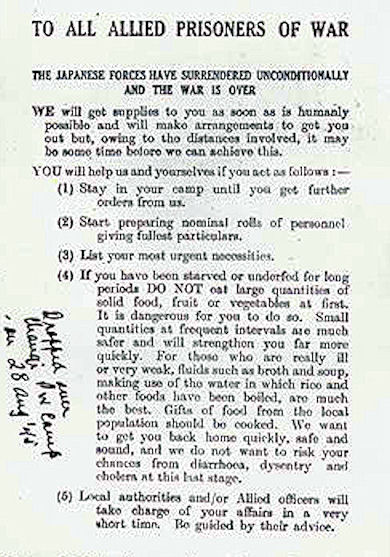 Planning for the evacuation and repatriation of released prisoners from the Far East, like that for prisoners in Italy and Germany, had been begun by the Imperial Prisoners of War Committee in late 1942. Towards the end of 1944 a draft directive was submitted to the Combined Chiefs of Staff and detailed planning began. Commanders-in-Chief in the Pacific were made responsible for the protection, maintenance, and evacuation of all United Nations prisoners of war within their respective operational zones, but were to co-ordinate their plans. These were to ensure provision for prisoners of war in any armistice agreement made with the enemy, to take control of prisoner-of-war camps, to see that liberated prisoners were properly cared for, to send back nominal rolls, to preserve enemy records concerning prisoners and to apprehend enemy personnel charged with their maltreatment.
Planning for the evacuation and repatriation of released prisoners from the Far East, like that for prisoners in Italy and Germany, had been begun by the Imperial Prisoners of War Committee in late 1942. Towards the end of 1944 a draft directive was submitted to the Combined Chiefs of Staff and detailed planning began. Commanders-in-Chief in the Pacific were made responsible for the protection, maintenance, and evacuation of all United Nations prisoners of war within their respective operational zones, but were to co-ordinate their plans. These were to ensure provision for prisoners of war in any armistice agreement made with the enemy, to take control of prisoner-of-war camps, to see that liberated prisoners were properly cared for, to send back nominal rolls, to preserve enemy records concerning prisoners and to apprehend enemy personnel charged with their maltreatment.
The surrender terms imposed on the Japanese made it obligatory on them to preserve the safety and well-being of all prisoners and civilian internees in their hands and to supply adequate food, shelter, clothing, and medical care until the Allied forces took over. Until this occurred, prisoner-of-war and civilian internment camps were to be handed over to the command of their camp leaders. To bring relief immediately after the armistice to prisoners of war and civilian internees, information leaflets, food, clothing, and medical supplies were dropped into camps from the air. Owing to the sudden collapse of Japan the only recovery teams immediately available were drawn from the Australian forces operating under the Command of General MacArthur; and the Australian authorities agreed that they should be available for dealing with all Commonwealth prisoners of war until the arrival of United Kingdom and other Commonwealth teams.
470 survivors from the original 900 men of the 2/26th. Battalion AIF embarked in the Largs Bay at Singapore for repatritation to Australia where the ship berthed on 7th. October 1945 - the ex POWs disembarked the next day for a parade through Brisbane.
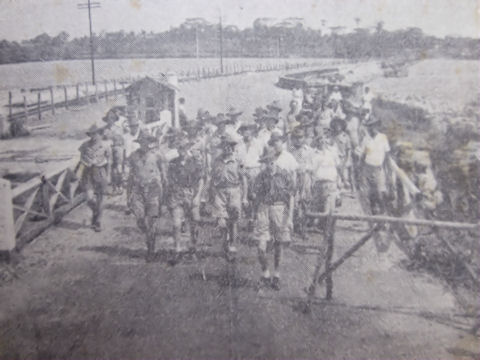 |
| Bob and some of the 2/26th. strolling over the Johore Baru causeway for a last look before leaving Singapore |
"We were sent home on the Largs Bay but didn't know how dirty we were"...
 |
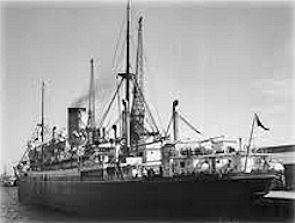 |
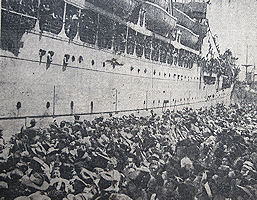 |
| Sailing from Singapore | The SS Largs Bay | A huge welcome home at Pinkenba, Brisbane |
